
Ron 2014
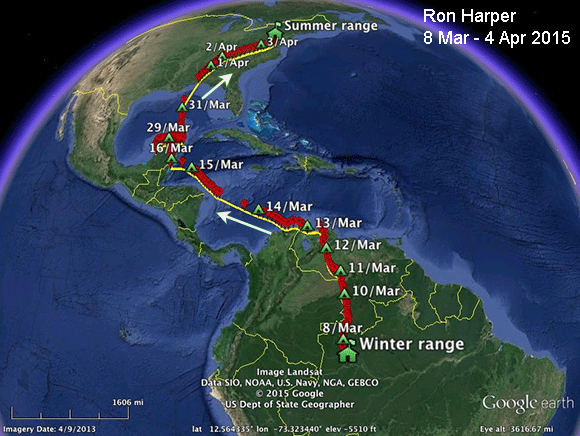 |
Heading home??Ron left his ox-bow lakearound 9 AM on the 8th and pushed north. All was proceeding normally until he got to northern Venezuela, where he headed due west and crossed the Caribbean on about the longest over-water path he could find. We've never seen anything like this before. I can't come up with a biological reason for the trip to Belize, so I'll have to suggest that he's a Republican and in protest to OBama's opening diplomatic relations with Cuba is going to boycot Cuba. This year he left 11 days earlier than last. It took him 23 days last year to get home on the Anacostia River in Washington, DC. This year he got home a week earlier than last year. Last year he was so late that his mate had already paired up with a new male and was on eggs when he arrived. He did not breed. This year, he found his old nest occupied again when he got home. It does not look like he's going to nest this year. Scroll down for a sequential chronology starting with last spring's migration. Or jump ahead to the start of the 2015 spring trip north. |
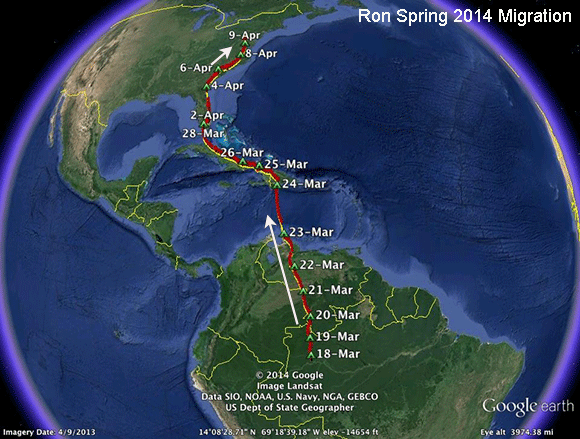 |
Ron's Spring 2014 MigrationRon got a very late start to his spring migration, leaving his wintering grounds on the 18th of March. He didn't get back to his nest until the 9th of April. The trip took 23 days. |
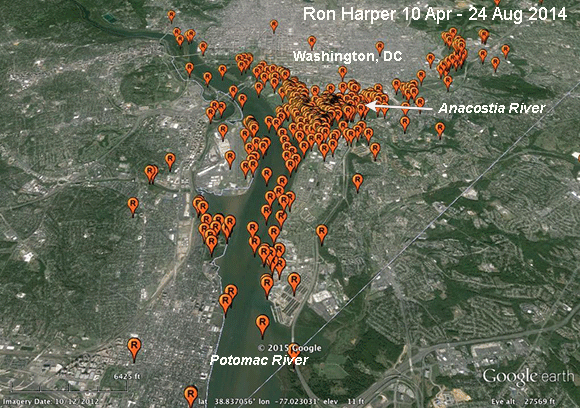 |
Ron's summer in DCRon was so late that when he arrived, his female had already paired with a new male and was incubating eggs. He spent an uneventful summer around the DC area, with no indication that he attempted to set up a nest with a new female. He rarely traveled farther than 3 miles from his old nest, which was about where the arrow for the Anacostia River points in this map. |
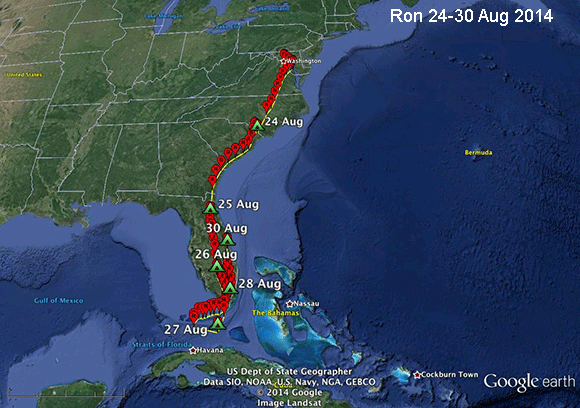 |
Fall migration begins: 24-30 Aug 2014Ron, our adult male from the Anacostia River in Washington, DC started his second migration wearing one of our transmitters on 24 Aug. He moved quickly down the coast to Florida. On the 26th, he started the day's migration around 9:30 and headed over the Florida Straits toward Cuba around 4:30PM. He should have reached Cuba about 4 hours later. Instead, 8 hours later we have a location in the middle of the Strait and then 6 hours later he was just 80 miles west of the midnight location, still out over the water. He must have landed on a boat sometime in the late afternoon of the 26th, ridden on it for a while, and then bailed out when he saw the Keys. That makes sense. He might have run into bad weather. But what happened next is totally baffling. |
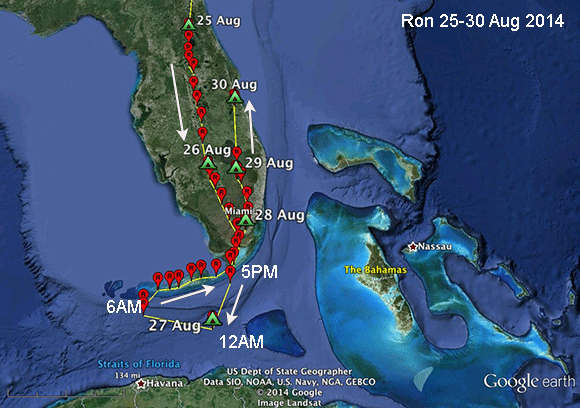 |
25-30 Aug 2014Ron turned around and headed north. It's not too surprising that he headed back north, but I was surprised to see him go that far. |
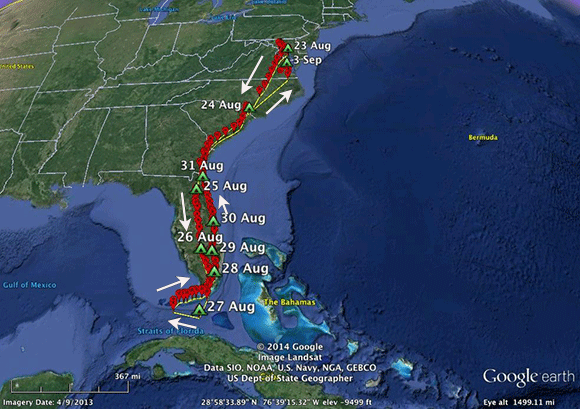 |
Back to DC?!Now it gets really weird. He retraced, more or less, his path up the east coast all the way to Virginia. On the 3rd of September, he was 120 miles south of his home range. On the 4th, he was back in DC! Besides the obvious joke that he must have forgotten his passport, there's really no explanation that makes any sense here. |
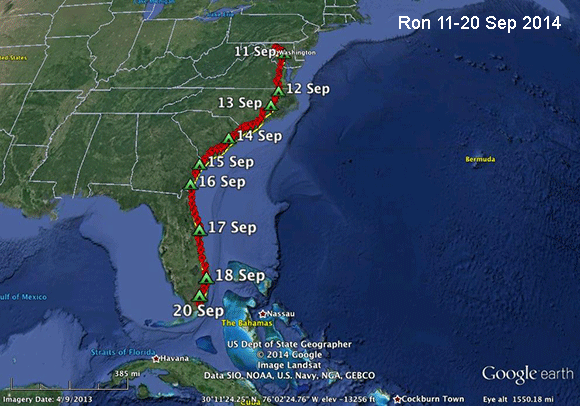 |
Migration - Take 2!Ron is off again. About three weeks after he started the first time, Ron restarted his migration and made it to the Everglades in 10 days. Who knows what's next? Not me! |
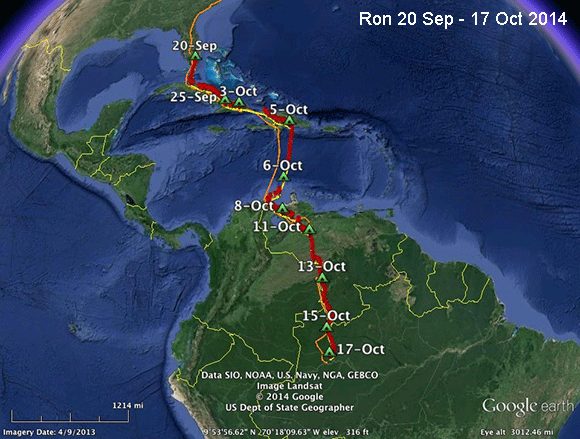 |
20 Sep - 15 OctRon is back on his wintering area on the Amazon, 55 days after he began this bizarre migration. His track south this fall is quite similar to the route he took in 2013, indicated here in orange. In 2013 he left Hispaniola at Cabo Beata, the typical launching spot for adults crossing the Caribbean. This year he moved a bit further east into the Dominican Republic before making the Caribbean crossing. |
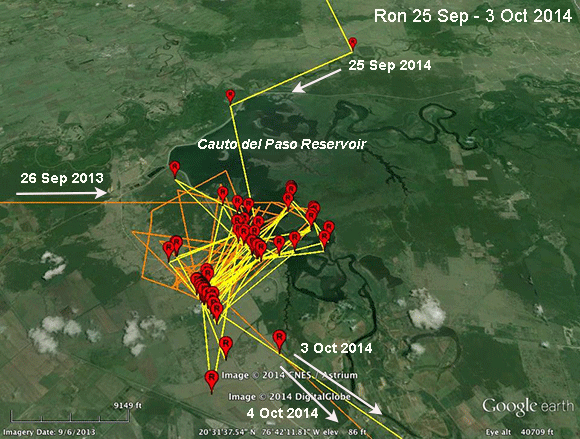 |
Refueling stop in CubaA creature of habit, Ron has a regular refeuling stop on his route to the Amazon. About two-thirds of the way down Cuba, he has stopped both years at the Cauto del Paso reservoir. Amazingly, he arrived and departed on almost exactly the same day both years. |
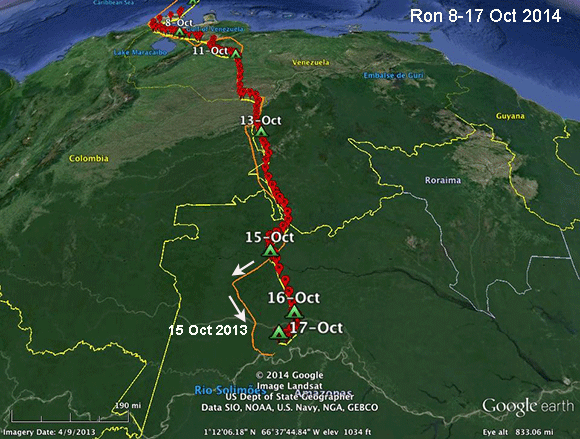 |
Finishing the tripRon moved steadly south across Venezuela and Brazil and arrived at his wintering area only two days later than he did in 2013. He did take a more direct route on the last couple of days than he did in 2013. |
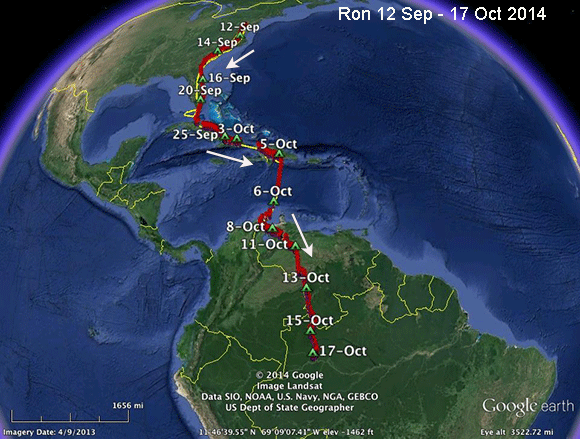 |
The complete fall tripHis whole marathon migration was the most bizarre thing we've ever seen a migrating Osprey do. It took 55 days, including 14 in stopovers. His roost-to-roost distance traveled was 5,776 miles (9,306 km). Mearuring his more complete path (connecting the dots between all GPS locations), we get a distance traveled of 6,247 miles (10,053 km). The last leg, after the strange round trip to the Florida Straits, was 3,792 miles (6,102 km). That was really all he needed to fly. The false start added 2,655 miles (3,951 km) to his Osprey-ometer. |
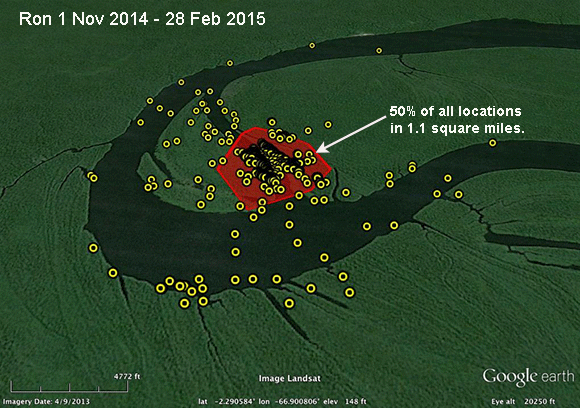 |
Safe and soundRon spent his 5 month winter stay on an ox-bow lake between the Amazon and Japura Rivers deep in the heart of the Brazilian Amazon. Amazingly, half of his hourly locations were in an area of just over 1 square mile. This is what we expect of adults. After some exploring on their first trip south, they settle on a spot that has lots of fish. Maybe the extra year they spend on the "wintering" area is a way to confirm that the spot is a really reliable fishing spot. The fidelity to a safe spot and the lack of movement once they've arrived in the fall means they will have a reduced chance of running into trouble in the form of humas. |
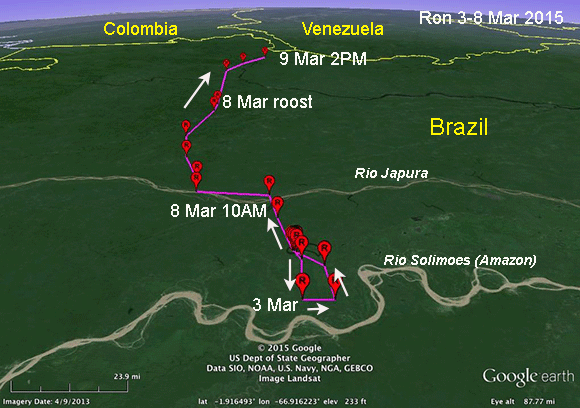 |
The second migration beginsAfter 5 months on his lake, Ron made a 4-hour junket south on 3 March. He had only made a couple of trips away from the lake during the whole winter. It's tempting to look at this as a warm-up flight prior to starting his migration. His hormones were clearly changing and getting him "in the mood" to migrate. This migratory restlessness is well-known in birds and has enabled us to learn much about migration. Ron started his migration 11 days earlier than last year. He was so late last year that when he got home to the Anacostia River in Washington, DC, his mate was already incubating eggs with a new male.
|
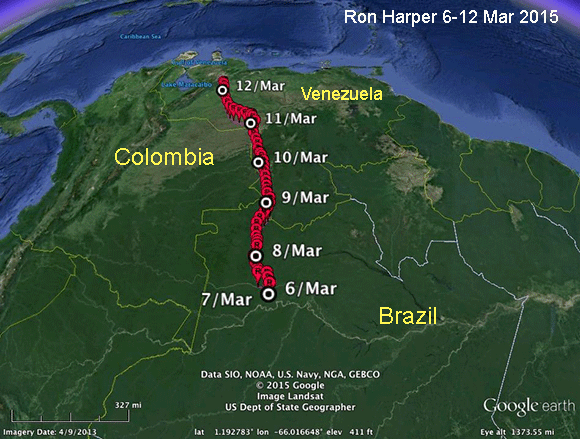 |
The second migration continuesAll normal here, moving steadily north. Still 10 days ahead of last year's trip.
|
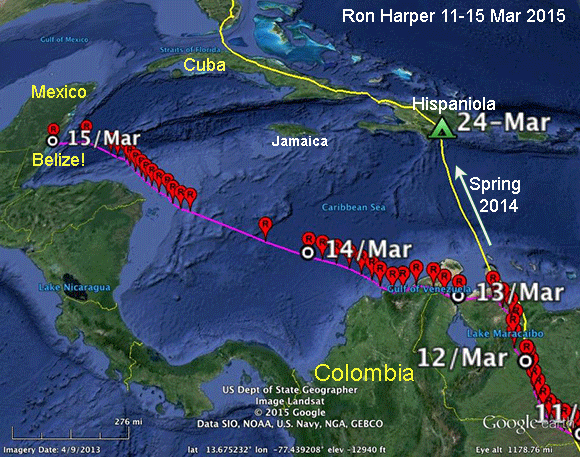 |
He did what?!We've never seen this before! We have seen some east-coast birds migrate from Cuba to Central America and then down into South America. They headed north through Central America on their way home. But we've never seen a bird go from Colombia over to the Yucatan. He arrived in Belize around 5AM. His trip over water was about 1,060 miles (1,700 km), which he covered in a just over 39 hours. There does not seem to have been any weather that would explain the strange migration. I guess we shouldn't be too surprised. After all, this is the bird that got half way from the Florida Keys to Cuba and then turned around and flew all the way back to D.C. before starting his migration all over again. I suspect he will stop and fish a bit along Belize's coast, where there are resident Ospreys of the Caribbean subspecies. He SHOULD go north up into Mexico and then across the Gulf. But will he go over to Cuba, or head straight north and hit Florida's Gulf coast? He sure doesn't seem to like Cuba. While he's way too far west, he is, lattitudinally at least, still 9 days ahead of last year's timetable. Stay tuned on this one! |
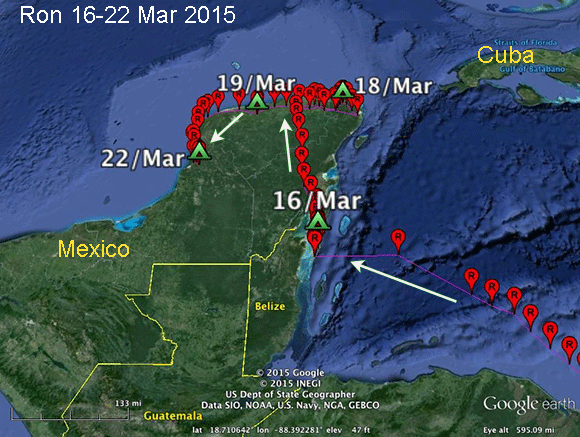 |
Looking for a way off the YucatanRon seems to be looking for a land route home. He already did 1,000 miles over open water and seems to be avoiding another crossing. The only way he could accomplish that will be to go around the Gulf of Mexico. I really don't expect him to do that, but some mid-western Ospreys follow that route. Stay tuned on this one! |
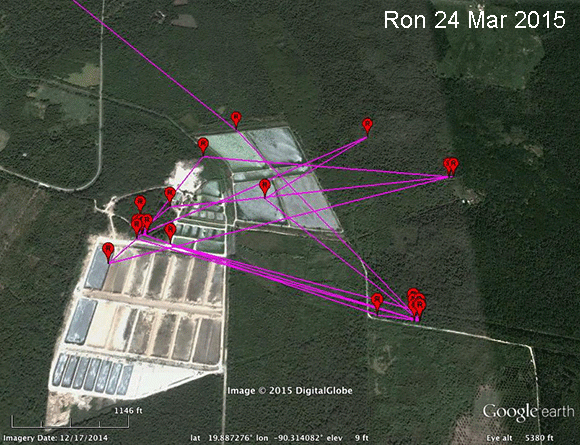 |
Looking for fish in all the wrong places.We hate to see this. It is the classic footprint of a fish farm. We've had too many birds arrive at this sort of spot and not get past it. The most frustrating was one of our early juveniles who spent 18 months in the Zapata swamps of Cuba and, on his first day heading north stopped at a fish farm and was never heard from again. My New Hampshire colleague Iain MacLeod has actually figured out what fish farm Ron is visiting. I sent an email to a listserv for ornithologists working in the Neotropics and within a day was in contact with two people who live near the tilapia farm. The next day Profa. Adriana Moncada went out to the fish farm and spoke to the workers there. She found out that there were about 10 Ospreys visiting the farm and that they were just scaring the Ospreys away, not shooting at them! They had seen Ron with his conspicuous antenna.
|
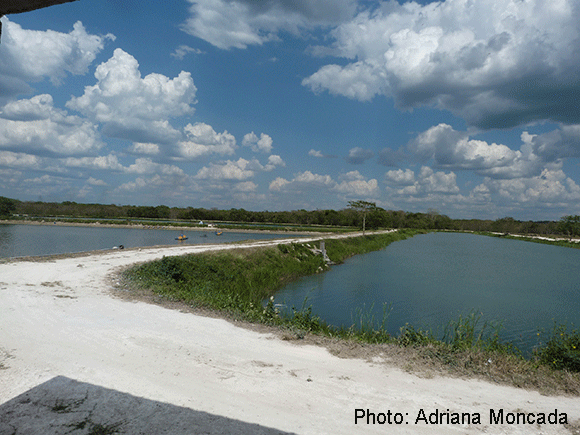 |
Looking for fish in all the wrong places.Here's a view of the tilapia farm where Ron spent a week.
|
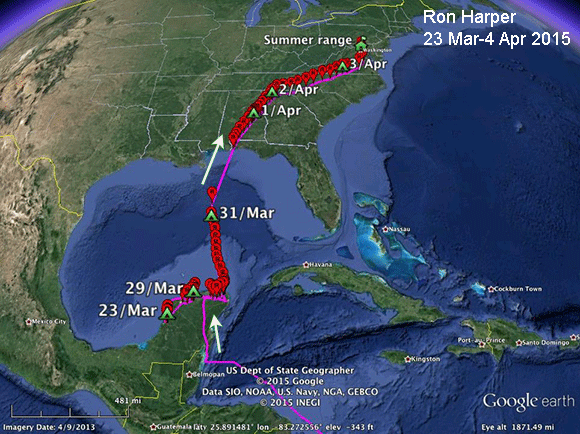 |
A quick trip home.On the 29th, after a week of easy fishing, Ron's hormones kicked in and he headed north across the Caribbean. The open water crossing was about 650 miles (1,015 km). Combined with his 1,010 miles (1,600 km) across the Caribbean, he covered 1,600 miles of open water--roughly three times what he would have done had he taken the more traveled route from S.A. to Haiti and Cuba and on to Florida. The rest of the trip was quick and direct. He had a big day on the 3rd of April (as did our other birds migrating through the mid-Atlantic states that day. Riding strong tailwinds, he covered 336 mi (590 km) in just over 10 hours. In the middle of the day he was flying between 40 and 50 mph, which is twice the average speed we see in migrating Ospreys.
|
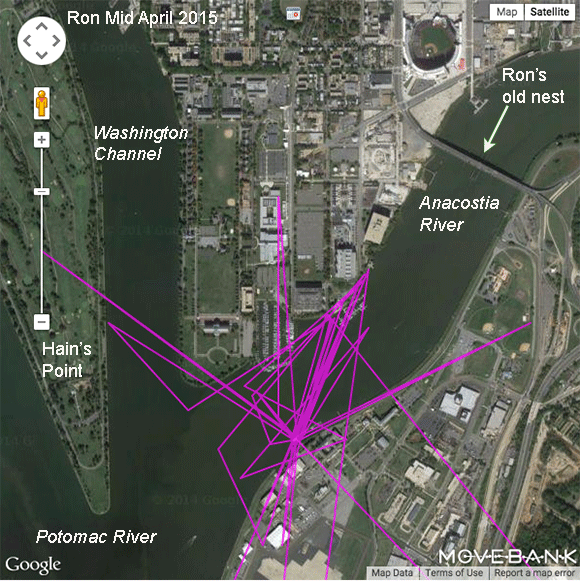 |
On the Anacostia.It doesn't look like Ron is nesting this year. He's spending a lot of time at two points on either bank of the Anacostia, but it doesn't look like there's anyplace to nest. I'm waiting for news from some of our spies in the area.
|
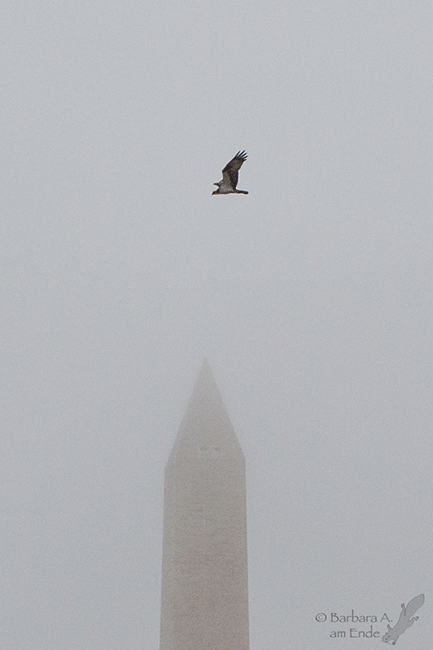 |
Ron does DC.Barbara am Ende was out and about one foggy day in April and saw an Osprey flying over the Tidal Basin. She knows our birds, so when she saw the antenna, she took the picture at left with the Washington Monument in the background and was kind enough to share it with us.
|